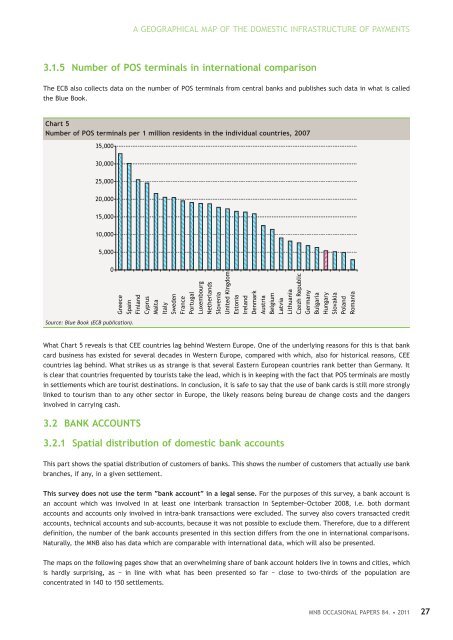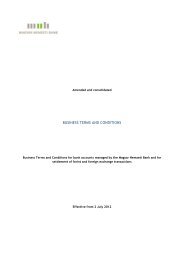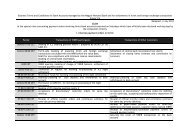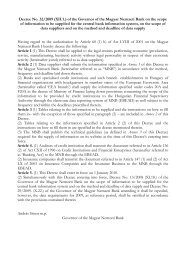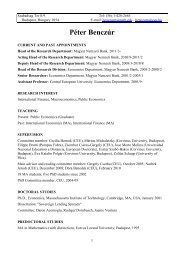The map of payments in Hungary - Magyar Nemzeti Bank
The map of payments in Hungary - Magyar Nemzeti Bank
The map of payments in Hungary - Magyar Nemzeti Bank
Create successful ePaper yourself
Turn your PDF publications into a flip-book with our unique Google optimized e-Paper software.
A GEOGRAPHICAL MAP OF THE DOMESTIC INFRASTRUCTURE OF PAYMENTS<br />
3.1.5 Number <strong>of</strong> POS term<strong>in</strong>als <strong>in</strong> <strong>in</strong>ternational comparison<br />
<strong>The</strong> ECB also collects data on the number <strong>of</strong> POS term<strong>in</strong>als from central banks and publishes such data <strong>in</strong> what is called<br />
the Blue Book.<br />
Chart 5<br />
Number <strong>of</strong> POS term<strong>in</strong>als per 1 million residents <strong>in</strong> the <strong>in</strong>dividual countries, 2007<br />
35,000<br />
30,000<br />
25,000<br />
20,000<br />
15,000<br />
10,000<br />
5,000<br />
0<br />
Greece<br />
Spa<strong>in</strong><br />
F<strong>in</strong>land<br />
Source: Blue Book (ECB publication).<br />
Cyprus<br />
Malta<br />
Italy<br />
Sweden<br />
France<br />
Portugal<br />
Luxembourg<br />
Netherlands<br />
Slovenia<br />
United K<strong>in</strong>gdom<br />
Estonia<br />
Ireland<br />
Denmark<br />
Austria<br />
Belgium<br />
Latvia<br />
Lithuania<br />
Czezh Republic<br />
Germany<br />
Bulgaria<br />
<strong>Hungary</strong><br />
Slovakia<br />
Poland<br />
Romania<br />
What Chart 5 reveals is that CEE countries lag beh<strong>in</strong>d Western Europe. One <strong>of</strong> the underly<strong>in</strong>g reasons for this is that bank<br />
card bus<strong>in</strong>ess has existed for several decades <strong>in</strong> Western Europe, compared with which, also for historical reasons, CEE<br />
countries lag beh<strong>in</strong>d. What strikes us as strange is that several Eastern European countries rank better than Germany. It<br />
is clear that countries frequented by tourists take the lead, which is <strong>in</strong> keep<strong>in</strong>g with the fact that POS term<strong>in</strong>als are mostly<br />
<strong>in</strong> settlements which are tourist dest<strong>in</strong>ations. In conclusion, it is safe to say that the use <strong>of</strong> bank cards is still more strongly<br />
l<strong>in</strong>ked to tourism than to any other sector <strong>in</strong> Europe, the likely reasons be<strong>in</strong>g bureau de change costs and the dangers<br />
<strong>in</strong>volved <strong>in</strong> carry<strong>in</strong>g cash.<br />
3.2 BANK ACCOUNTS<br />
3.2.1 Spatial distribution <strong>of</strong> domestic bank accounts<br />
This part shows the spatial distribution <strong>of</strong> customers <strong>of</strong> banks. This shows the number <strong>of</strong> customers that actually use bank<br />
branches, if any, <strong>in</strong> a given settlement.<br />
This survey does not use the term “bank account” <strong>in</strong> a legal sense. For the purposes <strong>of</strong> this survey, a bank account is<br />
an account which was <strong>in</strong>volved <strong>in</strong> at least one <strong>in</strong>terbank transaction <strong>in</strong> September−October 2008, i.e. both dormant<br />
accounts and accounts only <strong>in</strong>volved <strong>in</strong> <strong>in</strong>tra-bank transactions were excluded. <strong>The</strong> survey also covers transacted credit<br />
accounts, technical accounts and sub-accounts, because it was not possible to exclude them. <strong>The</strong>refore, due to a different<br />
def<strong>in</strong>ition, the number <strong>of</strong> the bank accounts presented <strong>in</strong> this section differs from the one <strong>in</strong> <strong>in</strong>ternational comparisons.<br />
Naturally, the MNB also has data which are comparable with <strong>in</strong>ternational data, which will also be presented.<br />
<strong>The</strong> <strong>map</strong>s on the follow<strong>in</strong>g pages show that an overwhelm<strong>in</strong>g share <strong>of</strong> bank account holders live <strong>in</strong> towns and cities, which<br />
is hardly surpris<strong>in</strong>g, as − <strong>in</strong> l<strong>in</strong>e with what has been presented so far − close to two-thirds <strong>of</strong> the population are<br />
concentrated <strong>in</strong> 140 to 150 settlements.<br />
MNB OCCASIONAL PAPERS 84. • 2011 27


